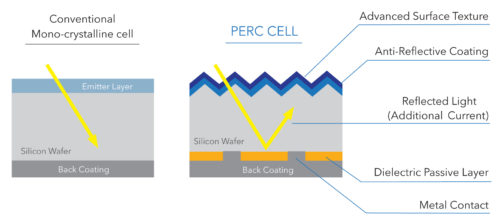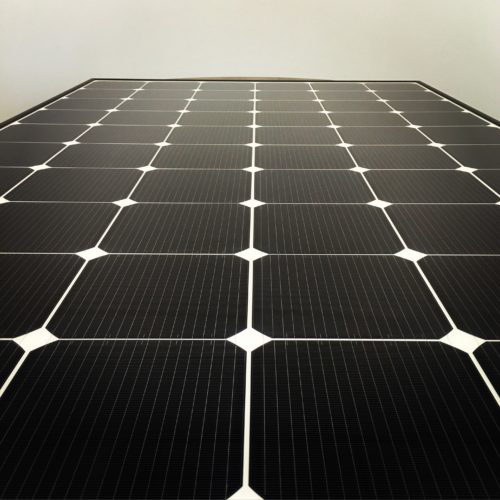
PERC solar cell (Passivated Emitter Rear Cell) stemmed from the1980s.Martin Green research group of the University of New South Wales first reported PERC solar cell structure in 1989.At that time, the efficiency of the PERC solar cell made in laboratory reached 22.8%.By the year 1999, the efficiency increased to 25%,setting a world record.PERC solar cell laboratory used lithography, evaporation, thermal oxygen passivation, electroplating and other technologies. The biggest difference between PERC and standard solar cell is back surface dielectric passivation,it uses local metallic contact,greatly decreasing back surface recombination velocity,and increasing back surface light reflex.
In 2006, There was an increasing awareness of the AIOx dielectric film for the P-type PERC solar cell back passivation.This made the industrialization of PERC solar cell became possible. Along with the maturity of technologies and equipment, PERC technology getting into industrialization.
In 2013, solar cell manufacturers began to use PERC solar cell production line.In recent years,PERC solar cell drawn more and more attention from the industry, production capacity is expanding rapidly.
In 2017 the global PERC solar cell production capacity is expected to increasing by 6.5GW.And 2.5GW standard solar cell production line will be updated to PERC solar cell production line.To the end of 2017 global PERC solar cell production capacity is expected to reaching 20GW.
Depending on which source is consulted, PERC stands for Passivated Emitter Rear Cell, Passivated Emitter Rear Contact or even Passivated Emitter and Rear Cell. PERC technology adds an extra layer to the rear-side of a solar cell. Manufacturers spent many years focusing on the front side of a solar cell, and less attention was paid to taking advantage of production opportunities from the backside. Incorporating PERC into a solar cell boosts generation.
In order to create a PERC cell, an additional two steps are employed to the standard back surface field (BSF) during the manufacturing process. First, a rear surface passivation film is applied. Second, lasers or chemicals are used to open the rear passivation stack and create tiny pockets in the film to absorb more light. Manufacturers can approach this in different ways (i.e. varying the recipe for the film and opening technique), but in every instance a dielectric passivation layer is added to the back of the cell.

In employing just two additional steps, the return is threefold: 1.) Electron recombination is significantly reduced; 2.) More light is absorbed; and 3.) Higher internal reflectivity is experienced. Not all sunlight is absorbed through non-PERC solar cells (some light passes straight through). But with a passivation layer on the rear side of a PERC cell, unabsorbed light is reflected by the additional layer back to the solar cell for a second absorption attempt. This process leads to a more efficient solar cell. This is great news for those across the spectrum of the industry.

The investment to move to a PERC technology line requires minimal modifications to existing cell manufacturing lines. Manufacturers can easily make the jump to produce a superior product without having to outlay large capital expenditures for a complete overhaul of existing equipment. There has been a boom in adding PERC capacity to the global market and it is set to continue at a rapid pace for the next several years. Additionally, panel manufacturers are now able to produce a more energy dense module without much of an increase in build cost.
Panels incorporating PERC technology give more freedom to developers and designers, especially when dealing with unorthodox spaces or locations that were once thought to be less than desirable for solar. PERC panels have a higher energy density per square foot and perform well under low-light conditions and high temperatures. When considering total energy production rather than peak wattage, it is clear PERC panels are superior. Designers can utilize fewer panels to accomplish total output goals where footprint is limited, or they can dramatically maximize energy output if space is not a premium. It empowers designers to be more flexible and responsive to project objectives.
This freedom also allows the option to drive down BOS costs. More is being achieved with less, which can trickle down to significantly reduced soft costs. This can be the difference between a client having sticker shock and not moving forward with project to one seeing a cost-effective and manageable system. Additionally, more attractive temperature coefficients make PERC a top performer in hotter climates, and less thermal loss is experienced. This allows end users to achieve superior performance from their systems throughout the year.
Being that PERC technology is neither new or radically different from standard cells, there is reduced risk on the financier’s side of the table to back an advanced technology. By utilizing a proven technology and modifying the standard cell, there is no change in the inherent risk of the module and its performance. Financiers should warm to the idea of panels manufactured with PERC technology. It sets a course for establishing dependable, long-term power output in a cost-effective manner for residential, commercial and utility projects. Total power generation over the lifetime of the solar system is increased without dramatically boosting the cost per watt.